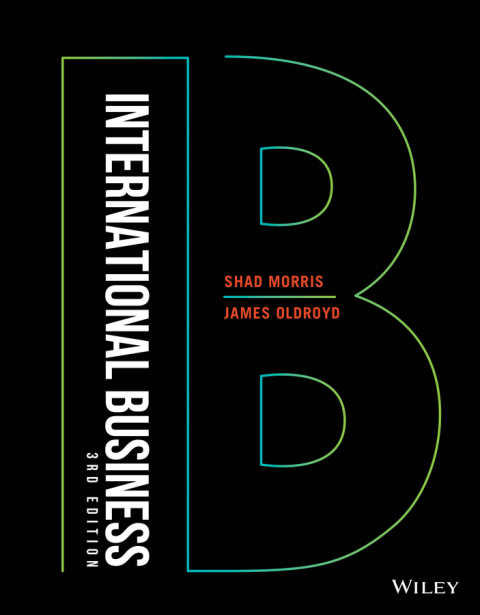Description
Efnisyfirlit
- Cover
- Contents
- INTERNATIONAL BUSINESS
- International Business
- Copyright
- ABOUT THE AUTHORS
- Preface
- Acknowledgments
- CHAPTER 1: Globalization
- 1.1 What Is Globalization?
- 1.2 The Flat World, Round World Globalization Debate
- 1.3 Governing Globalization
- 1.4 Managing Globalization
- Summary and Case
- CHAPTER 2: Analytical Tools for International Business
- 2.1 Why International Business?
- 2.2 External Environment
- 2.3 Internal Environment
- Summary and Case
- CHAPTER 3: Political Systems
- 3.1 The Political Spectrum
- 3.2 Political Risks
- 3.3 Measures of Political Freedom
- 3.4 Governmental Involvement in Business
- Summary and Case
- CHAPTER 4: The Legal Environment
- 4.1 Differing Legal Systems
- 4.2 Common Legal Issues for International Business
- 4.3 Illegal Versus Unethical Conduct
- 4.4 Important International Laws
- Summary and Case
- CHAPTER 5: Economic Systems
- 5.1 Understanding Economic Systems
- 5.2 Measuring Output
- 5.3 Governmental Economic Controls
- 5.4 Currency Fluctuation and Concentration Effects
- Summary and Case
- CHAPTER 6: Currency and Foreign Exchange
- 6.1 What Is Money?
- 6.2 Understanding Exchange Rates
- 6.3 The Consequences of Undervalued or Overvalued Currencies for International Businesses
- 6.4 Understanding and Managing Exchange Rate Risk
- Summary and Case
- CHAPTER 7: Trade
- 7.1 Theories of Trade
- 7.2 Trade Imbalances and Their Consequences
- 7.3 Patterns of Trade: Increased Regionalization
- 7.4 Government Policies Directed at Trade
- Summary and Case
- CHAPTER 8: Culture
- 8.1 What Is Culture?
- 8.2 What Does Culture Mean for Business?
- 8.3 Managing Cultural Differences
- 8.4 Building Cultural Intelligence
- Summary and Case
- CHAPTER 9: Sustainability
- 9.1 What Is Sustainability?
- 9.2 Fighting Short-Termism
- 9.3 Collaborating for Sustainability
- 9.4 Sustainability and Innovation
- Summary and Case
- CHAPTER 10: Poverty
- 10.1 Causes and Consequences of Global Poverty
- 10.2 Traditional Responses to Poverty
- 10.3 A Business Response to Poverty
- 10.4 Doing Well and Doing Good
- Summary and Case
- CHAPTER 11: Technological Change and Infrastructure
- 11.1 Technology as Physical Infrastructure
- 11.2 Technology of Information Infrastructure
- 11.3 Technology of Human Infrastructure
- 11.4 Technology Trends in International Business
- Summary and Case
- CHAPTER 12: Global Innovation and Intellectual Property
- 12.1 Innovation as a Tool for Global Growth
- 12.2 Investing in Innovation
- 12.3 Driving a Culture of Innovation
- 12.4 Protecting Intellectual Property
- Summary and Case
- CHAPTER 13: Country Selection and Entry Modes
- 13.1 Deciding Which Foreign Markets to Enter
- 13.2 Entry Modes
- 13.3 Make, Ally, or Buy
- Summary and Case
- CHAPTER 14: International Strategy
- 14.1 What Is Strategy?
- 14.2 Becoming Locally Responsive
- 14.3 Achieving Global Integration
- 14.4 Choosing an International Strategy
- Summary and Case
- CHAPTER 15: International Organizational Structures
- 15.1 Types of Organizational Structures
- 15.2 Informal Organizational Controls
- 15.3 Reducing the Need for Coordination Among Subsidiaries: Virtual Organizations, Standards, and Modularity
- 15.4 Horizontal Subsidiary Coordination
- Summary and Case
- CHAPTER 16: Global Leadership
- 16.1 What Is Global Leadership?
- 16.2 Global Leadership Competencies
- 16.3 Building Global Leadership Competencies in Others
- 16.4 Building Global Leadership Competencies in Yourself
- Summary and Case
- CHAPTER 17: Global Marketing
- 17.1 Global Market Segmentation
- 17.2 Standardization versus Differentiation in International Marketing
- 17.3 Global Branding
- 17.4 Global Pricing and Distribution
- Summary and Case
- CHAPTER 18: Global Operations and Supply-Chain Management
- 18.1 Global Procurement
- 18.2 Global Production
- 18.3 Global Supply Chains
- 18.4 Using Data Analytics to Improve Supply Chains
- Summary and Case
- CHAPTER 19: Global Human Resource Management
- 19.1 The Global HR Wheel
- 19.2 Human Capital in the Global Context
- 19.3 Meeting Strategic Objectives Through Human Capital
- 19.4 Tasks of the Global HR Function
- Summary and Case
- CHAPTER 20: Global Finance and Accounting
- 20.1 Financing International Trade and Investment
- 20.2 Capital Budgeting for Multinational Companies
- 20.3 International Accounting Standards
- 20.4 Global Tax Matters
- Summary and Case
- Glossary
- Glossary
- Wiley End User License Agreement






